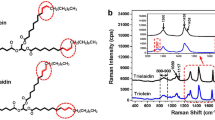Abstract
The solid fat contents (SFC) of heated edible oil samples were measured and found to correlate positively with total polar compounds (TPC) and inversely with triglyceride concentration. Traditional methods for determination of TPC require a laboratory setting and are time and solvent intensive. Therefore, SFC analysis represents a viable user-friendly alternative to measuring total polar components in environments where low-resolution NMR may already be in use, for example, in quality assurance environments. The slope of SFC measurements versus time was also found to correlate with the oxidative stability index of the edible oils studied.




Similar content being viewed by others
References
Baixauli R, Salvador A, Fiszman SM, Calvo C (2002) Effect of oil degradation during frying on the color of fried, battered squid rings. J Am Oil Chem Soc 79:1127–1131
Yanishlieva NV, Marinova EM (2001) Stabilisation of edible oils with natural antioxidants. Eur J Lipid Sci Technol 103:752–767
Choe E, Min DB (2007) Chemistry of deep-fat frying oils. J Food Sci 72:R77–R86
Sanibal EAA, Mancini-Filho J (2004) Frying oil and fat quality measured by chemical, physical, and test kit analyses. J Am Oil Chem Soc 81:847–852
Chu Y-H (1991) A comparative study of analytical methods for evaluation of soybean oil quality. J Am Oil Chem Soc 68:379–384
Mancini-Filho J, Smith LM, Creveling RK, Al-Shaikh HF (1986) Effects of selected chemical treatments on quality of fats used for deep frying. J Am Oil Chem Soc 63:1452–1456
Gertz C (2000) Chemical and physical parameters as quality indicators of used frying fats. Eur J Lipid Sci Technol 102:566–572
Hamed SF, El-Wafa GA, El-Ghorab A, Shibamoto T (2011) Quality assessment of heated cooking oil, Agab, using a simple newly-developed spectrophotometric method. J Am Oil Chem Soc 88:1851–1855
Marquez-Ruiz G, Jorge N, Martin-Polvillo M, Dobarganes MC (1996) Rapid quantitative determination of polar compounds in fats and oils by solid-phase extraction and size-exclusion chromatography using monostearin as internal standard. J Chromatogr A 749:55–60
Schulte E (2004) Economical micromethod for determination of polar components in frying fats. Eur J Lipid Sci Technol 106:772–776
Sebedio JL, Septier C, Grandgirard A (1986) Fractionation of commercial frying oil samples using sep-pak cartridges. J Am Oil Chem Soc 63:1541–1543
Melton SL, Jafar S, Sykes D, Trigiano MK (1994) Review of stability measurements for frying oils and fried food flavor. J Am Oil Chem Soc 71:1301–1308
Ruiz-Gutierrez V, Perez-Camino MC (2000) Update on solid-phase extraction for the analysis of lipid classes and related compounds. J Chromatogr A 885:321–341
Stier RF (2004) Tests to monitor quality of deep-frying fats and oils. Eur J Lipid Sci Technol 106:766–771
Fritsch CW, Egberg DC, Magnuson JS (1979) Changes in dielectric constant as a measure of frying oil deterioration. J Am Oil Chem Soc 56:746–750
Allendorf M, Subramanian A, Rodriguez-Saona L (2011) Application of a handheld portable mid-infrared sensor for monitoring oil oxidative stability. J Am Oil Chem Soc. doi:10.1007/s11746-011-1894-9
Donner MG, Richter WO (2000) International symposium on deep-fat frying—optimal operation. Eur J Lipid Sci Technol 102:306–308
Timms RE (1985) Physical properties of oils and mixtures of oils. J Am Oil Chem Soc 62:241–249
Haighton AJ, Van Putte K, Vermaas LF (1972) Determination of the solid contents of fats by wide-line nuclear magnetic resonance: the signal of liquid oils. J Am Oil Chem Soc 49:153–156
AOCS (1998) Official methods and recommended practices of the American oil chemists’ society, 5th edn. AOCS Press, Champaign
Warner K, Mounts TL, Kwolek WF (1985) Effects of antioxidants, methyl silicone and hydrogenation on room odor of soybean cooking oils. J Am Oil Chem Soc 62:1483–1486
Sims RJ, Fioriti JA, Kanuk MJ (1972) Sterol additives as polymerization inhibitors for frying oils. J Am Oil Chem Soc 49:298–301
Gordon MH, Magos P (1983) The effect of sterols on the oxidation of edible oils. Food Chem 10:141–147
Evans CD, Warner K, List GR, Cowan JC (1972) Room odor evaluation of oils and cooking fats. J Am Oil Chem Soc 49:578–582
Xu X-Q (1999) A modified VERI-FRY® quick test for measuring total polar compounds in deep-frying oils. J Am Oil Chem Soc 79:1087–1089
Romero A, Cuesta C, Sa′nchez-Muniz FJ (1999) Does frequent replenishment with fresh monoenoic oils permit the frying of potatoes indefinitely? J Agric Food Chem 47:1168–1173
Todt H, Guthausen G, Burk W, Schmalbein D, Kamlowski A (2006) Water/moisture and fat analysis by time-domain NMR. Food Chem 96:436–440
Duval FP, van Duynhoven PM, Bot A (2006) Practical Implications of the phase-compositional assessment of lipid-based food products by time-domain NMR. J Am Oil Chem Soc 83:905–912
Bruker Optics. Solid Fat Content (TD-NMR). http://www.brukeroptics.com/solidfat.html. Accessed 5 Jan 2012
Acknowledgments
The authors would like to thank Linda Parrott and Julie Anderson for their excellent and careful technical assistance, and Jeffrey Hartgerink for useful discussion.
Author information
Authors and Affiliations
Corresponding author
Additional information
Mention of trade names or commercial products in this article is solely for the purpose of providing scientific information and does not imply recommendation or endorsement by the US Department of Agriculture. The USDA is an equal opportunity provider and employer.
About this article
Cite this article
Bakota, E.L., Winkler-Moser, J.K. & Palmquist, D.E. Solid Fat Content as a Substitute for Total Polar Compound Analysis in Edible Oils. J Am Oil Chem Soc 89, 2135–2142 (2012). https://doi.org/10.1007/s11746-012-2121-z
Received:
Revised:
Accepted:
Published:
Issue Date:
DOI: https://doi.org/10.1007/s11746-012-2121-z




